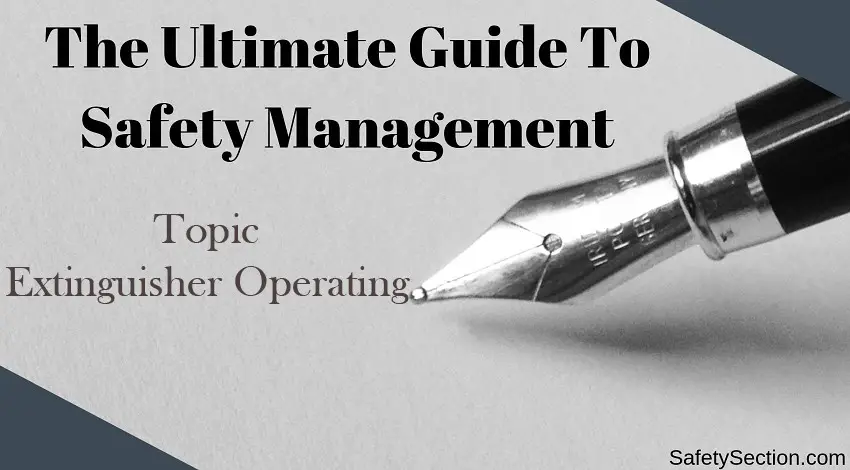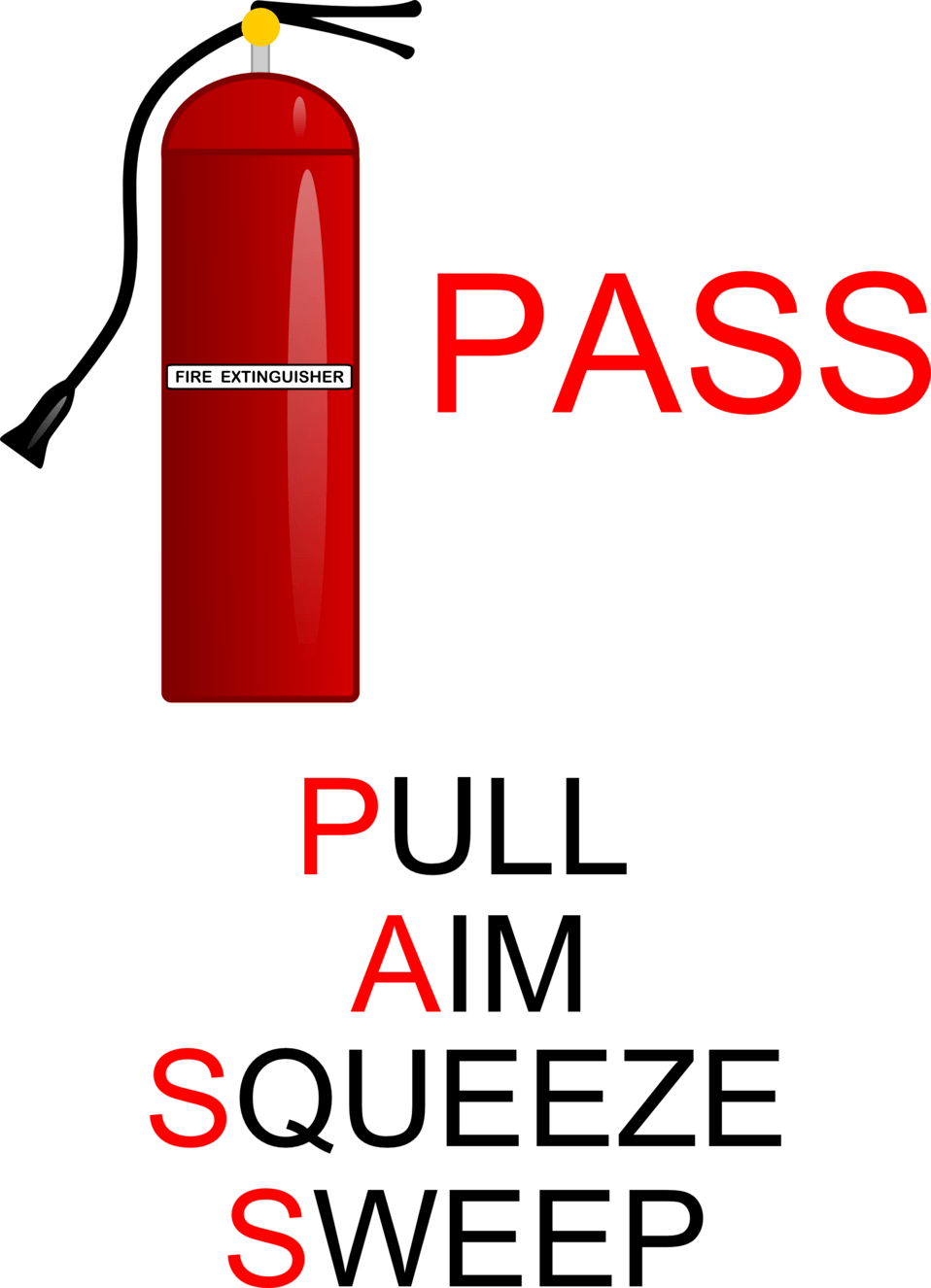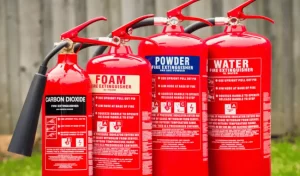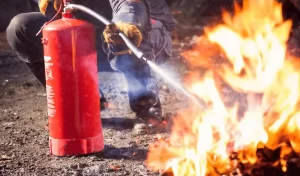Fire extinguishers are essential safety tools for homes, businesses, and vehicles. Knowing how to use one properly can mean the difference between a small fire being contained or becoming a life-threatening emergency.

Different types of fire extinguishers are designed to fight different classes of fire. Remember they have limited capacity and will typically work for about 10-30 seconds depending on size, so use them wisely.
The most common types of fire extinguishers are:
1. Dry Powder (ABC, AD, BC)
2. Carbon Dioxide (CO2)
3. Foam Spray
4. Water (Air Pressurized Water-APW)
In this guide, we’ll walk you through the fire extinguisher operating procedure, the different types of extinguishers, and important safety tips everyone should know.
Fire Extinguisher Operating Procedure

To operate an extinguisher:
Pull = Pull the Pin
Aim = Aim nozzle at the base of the fire
Squeeze = Squeeze the handle
Sweep = Sweep nozzle side to side
The most widely accepted method for using a fire extinguisher is the PASS technique:
1. Pull the Pin
- This unlocks the operating lever and allows you to discharge the extinguisher.
- Keep the nozzle pointed away from you when pulling the pin.
2. Aim Low
- Point the nozzle or hose at the base of the fire.
- Aiming at the flames won’t be effective—you need to target the fuel source.
3. Squeeze the Lever
- Slowly and evenly squeeze the handle to release the extinguishing agent.
- Releasing the handle will stop the discharge.
4. Sweep from Side to Side
- Move the nozzle from side to side at the base of the fire until it appears to be out.
- Watch the area for re-ignition and be prepared to repeat if necessary.
Types of Fire Extinguishers and Their Uses

Different fire extinguishers are designed for specific types of fires. Always check the label to ensure you’re using the right one:
- Class A – For ordinary combustibles like wood, paper, cloth.
- Class B – For flammable liquids such as gasoline, oil, and grease.
- Class C – For electrical fires.
- Class D – For combustible metals (mainly in industrial settings).
- Class K – For kitchen fires involving cooking oils and fats.
Many home and office fire extinguishers are ABC-rated, meaning they’re suitable for most common fires.
Before You Use a Fire Extinguisher: Assess the Situation
Before operating a fire extinguisher, evaluate the following:
- Is the fire small and contained? You should only fight fires in their early stages.
- Is everyone evacuated? Ensure people are out of harm’s way.
- Is there a clear escape route? Never let a fire block your exit.
- Is the correct type of extinguisher available? Using the wrong type can make the fire worse.
If the fire is spreading rapidly or you feel unsafe, evacuate immediately and call 911.
Fire Extinguisher Safety Tips
- Inspect extinguishers monthly to ensure they are charged and in working condition.
- Mount them in accessible locations, such as near exits or kitchens.
- Replace or recharge extinguishers after use or if the pressure gauge shows low.
- Attend a fire safety training course if possible to gain hands-on experience.
Fire Extinguisher Placement

Proper fire extinguisher placement is crucial for effective fire safety. Even the best extinguisher won’t help if you can’t reach it in time.
Whether at home, in the workplace, or in public buildings, strategic positioning ensures you’re prepared for emergencies.
We will explain where fire extinguishers should be placed, legal requirements, and best practices for accessibility and visibility.
General Guidelines for Fire Extinguisher Placement
To maximize safety and compliance:
- Mount extinguishers on walls or in clearly marked cabinets.
- Install them at eye level, typically 3.5 to 5 feet above the floor.
- Keep them visible and unobstructed—never behind furniture or doors.
- Mark locations with signage, especially in large buildings or corridors.
- Ensure they are easily accessible without needing to pass through a potential fire zone.
Recommended Locations by Area
Home
- Kitchen: Near (but not directly above) the stove—ideal for grease fires.
- Garage or workshop: Where flammable materials or tools are stored.
- Laundry room: Especially if using gas dryers.
- Each floor of your home: Including basement and upper levels.
Workplace or Office
- Break rooms or kitchens: Due to heat sources.
- Electrical rooms: For potential Class C fires.
- Exit routes and stairwells: So employees can grab one while exiting.
- Mechanical and storage areas: High risk for various fire classes.
Commercial & Public Buildings
- Every 75 feet of travel distance (as per OSHA and NFPA guidelines).
- Near fire hazard zones (fuel storage, welding stations, chemical areas).
- By exits, elevators, and emergency equipment stations.
Legal Requirements & Standards
Fire extinguisher placement is regulated by:
- NFPA 10 (National Fire Protection Association) – Specifies distance and mounting height requirements.
- OSHA (Occupational Safety and Health Administration) – Requires proper placement in workplaces.
- Local fire codes – May have additional rules depending on jurisdiction.
Always consult your local fire marshal or building inspector for specific compliance guidelines.
Mounting & Installation Tips
- Use brackets or wall mounts rated for the size and weight of the extinguisher.
- For large buildings, consider fire extinguisher cabinets with break-glass panels.
- Place signs above the extinguisher so it’s easy to spot from across the room.
- Ensure it’s located in a temperature-controlled area to avoid freezing or pressure loss.
Correct fire extinguisher placement is a critical part of fire safety planning. Whether for your home or workplace, following established guidelines and ensuring easy access can save lives and reduce property damage.
Remember: a fire extinguisher is only helpful if you can reach it quickly when it matters most. Regularly inspect and maintain all units—and keep your environment fire-ready.
Fire Extinguisher Operating Procedure Mistakes

Here are some of the most common fire extinguisher operating procedure mistakes—knowing these can help you respond more effectively and safely in an emergency:
1. Not Knowing the PASS Technique
Mistake: Failing to remember the steps: Pull, Aim, Squeeze, Sweep
Why it’s a problem: In an emergency, hesitation or confusion can waste precious seconds and allow the fire to grow.
2. Using the Wrong Type of Extinguisher
Mistake: Attempting to extinguish electrical or grease fires with a water-based extinguisher (Class A only)
Why it’s a problem: This can spread the fire or cause electrocution. Always match the extinguisher to the fire type (e.g., ABC-rated for general use).
3. Aiming at the Flames Instead of the Base
Mistake: Spraying the extinguisher at the top of the flames
Why it’s a problem: The flames may look impressive, but the fire feeds on what’s burning at the base. Aim low to cut off the fuel source.
4. Standing Too Close (or Too Far)
Mistake: Standing right on top of the fire or too far away
Why it’s a problem: Too close and you risk injury; too far and the spray might not reach effectively. Start from about 6–8 feet away and move closer as needed.
5. Forgetting to Pull the Pin
Mistake: Squeezing the handle without removing the pin
Why it’s a problem: The extinguisher won’t discharge unless the pin is pulled. This is a common error during panic.
6. Not Checking the Extinguisher First
Mistake: Grabbing an extinguisher without checking the pressure gauge or condition
Why it’s a problem: A discharged, expired, or damaged extinguisher won’t work when you need it most. Monthly checks are essential.
7. Not Having a Clear Escape Route
Mistake: Backing into a corner or letting fire block your way out
Why it’s a problem: Always keep a safe exit behind you. If the fire spreads, you must be able to retreat safely.
8. Delaying the Call to 911
Mistake: Trying to fight a fire for too long before calling emergency services
Why it’s a problem: Fires can escalate quickly. Call 911 first (if possible), then attempt to extinguish if it’s safe and manageable.
9. Not Practicing or Receiving Training
Mistake: Handling a fire extinguisher for the first time during an actual fire
Why it’s a problem: Lack of familiarity leads to mistakes. Hands-on training or drills greatly improve readiness.
Frequently Asked Questions
1. What is the correct way to use a fire extinguisher?
Answer:
The correct method is the PASS technique:
-
Pull the pin
-
Aim the nozzle at the base of the fire
-
Squeeze the handle
-
Sweep from side to side
This ensures effective and safe use of the extinguisher.
2. How do I know which type of fire extinguisher to use?
Answer:
Check the label on the extinguisher for its class rating:
-
Class A: Wood, paper, fabric
-
Class B: Flammable liquids like oil or gasoline
-
Class C: Electrical fires
-
Class D: Combustible metals
-
Class K: Cooking oils/fats (commercial kitchens)
Many home extinguishers are ABC-rated, covering the most common fire types.
3. Can I use a fire extinguisher on any size fire?
Answer:
No. Fire extinguishers are intended for small, contained fires in their early stages. If the fire is spreading rapidly or fills the room with smoke, evacuate immediately and call 911.
4. What should I do if the fire reignites after using the extinguisher?
Answer:
Stay calm, reassess the fire, and if it’s safe, repeat the PASS steps. If the fire continues to grow or if visibility decreases, evacuate immediately and let emergency services handle it.
5. Do I need training to use a fire extinguisher?
Answer:
While not required for everyone, hands-on fire extinguisher training is highly recommended. Many fire departments or safety organizations offer classes. Training helps build confidence and ensures you can act quickly and correctly in a real emergency.
Final Thoughts
Understanding the fire extinguisher operating procedure is a simple yet potentially life-saving skill. By learning and practicing the PASS technique—Pull, Aim, Squeeze, Sweep—you’ll be better prepared to respond quickly and effectively in the event of a small fire. Just as important is knowing which type of extinguisher to use, ensuring it’s well-maintained, and recognizing when it’s time to evacuate and call for professional help.
Remember: a fire extinguisher is a first response tool, not a substitute for the fire department. Always prioritize safety, keep extinguishers easily accessible, and make sure everyone in your household or workplace knows how to use one. Being prepared today can make all the difference tomorrow.
Related Posts:
- How Many Fire Extinguishers Do I Need?
- Comparison Of Fire Classes
- Fire Suppression System Meaning
- How To Use Fire Fighting Equipment
- Top 15 Useful Fire Safety Tips That You Should Know
- 12 Best Fire Extinguisher Reviews
